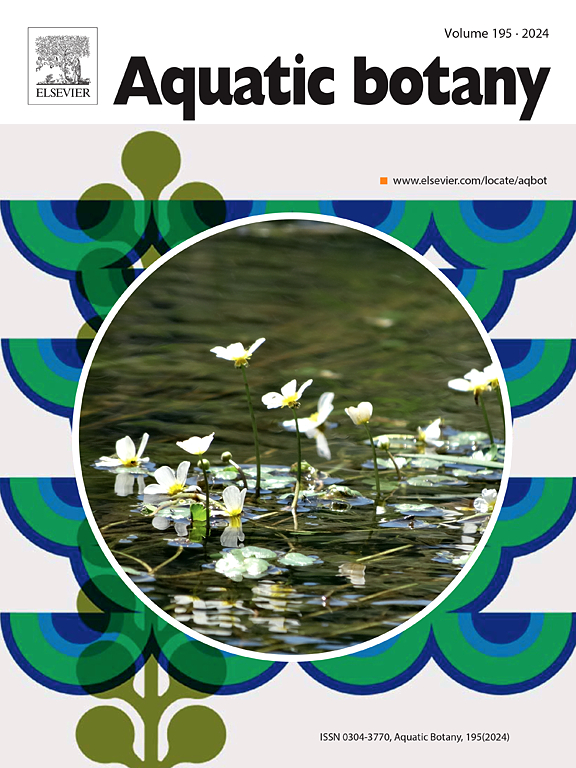Demographic and morphological responses of intertidal eelgrass (Zostera marina) transplanted across sediment conditions
IF 2.6
4区 生物学
Q2 MARINE & FRESHWATER BIOLOGY
引用次数: 0
Abstract
Eelgrass (Zostera marina) shows substantial spatiotemporal variation in morphological and demographic traits that can arise from phenotypic plasticity. These traits commonly shift across light and depth gradients, as well as seasonally, but less consistency has been demonstrated across sediment conditions. We conducted two field transplant experiments in which seedlings or overwintering shoots of Z. marina were moved among sand and muddy-sand sites within a bay (Willapa Bay, Washington, USA). Shoots were regularly re-marked and measured for size, asexual, and sexual reproduction for 1–1.5 year, and upon collection, for rhizome extension and root investment. Seedlings, which were sourced from one site, had poor survival in muddy-sand, but smaller size and more branching with less flowering in sand. Shape also exhibited phenotypic plasticity, with relatively wide leaves and longer rhizome internodes at the sandier site. Overwintering shoots, which were transplanted among four sites in a fully reciprocal design, had lower survival and size after 6 months at sand compared to muddy-sand sites, but with greater root investment at collection. Shoots from one muddy-sand site, regardless of outplant site, maintained relatively short internodes over 1.5 years. Overall, shoots tended to remodel in summer as a function of sediment type, while internode extension was phenotypically plastic in both experiments, as well as fixed by source. Because sediment correlated with water movement, eelgrass traits expressed in sand could reduce drag (smaller above-ground size) and provide anchorage (root investment). Shorter internodes at muddy-sand outplant sites and from one muddy-sand source site could influence space-filling and foraging strategies. Across experiments, poor survival of seedlings relative to vegetative shoots in muddy-sand may reflect low-oxygen conditions that are challenging for early life stages of eelgrass to overcome. The substantial trait variation in transplants across sediment type could be a response to below-ground chemistry and above-ground hydrodynamics, but these drivers were not distinguishable with the study design.
潮间带大叶藻(Zostera marina)跨泥沙条件移植的人口统计学和形态学响应
大叶藻(Zostera marina)在形态和人口统计学特征上表现出明显的时空差异,这可能是由表型可塑性引起的。这些特征通常在光线和深度梯度以及季节变化中发生变化,但在沉积物条件下的一致性较少。在美国华盛顿州威拉帕湾(Willapa bay, USA)的沙地和泥沙场地中,我们进行了两次野外移栽试验,将Z. marina的幼苗或越冬芽移栽。在1-1.5年期间,定期重新标记和测量芽的大小、无性生殖和有性生殖,并在收集后进行根茎延伸和根投资。来自同一地点的幼苗在泥沙中成活率较差,但在沙中体积小,分枝多,开花少。形状也表现出表型可塑性,在砂质部位叶片相对较宽,根茎节间较长。在完全对等设计下,4个地点间移栽的越冬苗6个月后在沙地上的成活率和大小均低于泥沙地点,但在收集时根系投入较大。不论外植地在何处,同一泥沙地点的芽在1.5年以上保持相对较短的节间。总体而言,由于泥沙类型的关系,芽在夏季有重塑的趋势,而节间伸展在两个试验中都是表型塑性的,并且是由源固定的。由于泥沙与水的运动相关,大叶藻在沙子中表达的特性可以减少阻力(较小的地上尺寸)并提供锚点(根系投资)。泥质砂外植地和同一泥质砂源地的节间较短会影响空间填充和觅食策略。在实验中,与营养芽相比,泥沙中幼苗的存活率较低,这可能反映了低氧条件,这对鳗草的早期生命阶段来说是一个挑战。在不同泥沙类型的移植物中,大量的性状变化可能是对地下化学和地上流体动力学的响应,但这些驱动因素在研究设计中无法区分。
本文章由计算机程序翻译,如有差异,请以英文原文为准。
求助全文
约1分钟内获得全文
求助全文
来源期刊

Aquatic Botany
生物-海洋与淡水生物学
CiteScore
3.80
自引率
5.60%
发文量
70
审稿时长
6 months
期刊介绍:
Aquatic Botany offers a platform for papers relevant to a broad international readership on fundamental and applied aspects of marine and freshwater macroscopic plants in a context of ecology or environmental biology. This includes molecular, biochemical and physiological aspects of macroscopic aquatic plants as well as the classification, structure, function, dynamics and ecological interactions in plant-dominated aquatic communities and ecosystems. It is an outlet for papers dealing with research on the consequences of disturbance and stressors (e.g. environmental fluctuations and climate change, pollution, grazing and pathogens), use and management of aquatic plants (plant production and decomposition, commercial harvest, plant control) and the conservation of aquatic plant communities (breeding, transplantation and restoration). Specialized publications on certain rare taxa or papers on aquatic macroscopic plants from under-represented regions in the world can also find their place, subject to editor evaluation. Studies on fungi or microalgae will remain outside the scope of Aquatic Botany.
 求助内容:
求助内容: 应助结果提醒方式:
应助结果提醒方式:


